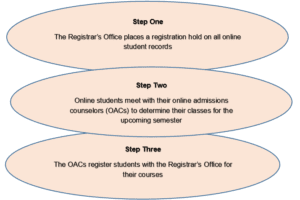Volume 36 Number 6 | December 2022
The is the first half of a two-part article. Read Part 2 here.
Elizabeth A. Gockel-Blessing, PhD, MLS(ASCP)CM
Amanda Reed, MAE, MLS(ASCP)CM

Building an online program can put stress on existing information technology (IT) infrastructure. IT infrastructure in this context is defined as the set of components that comprise an IT service. For IT infrastructure to be successful, there must be adequate bandwidth. Verizon.com defines bandwidth as “the maximum amount of data transmitted over an internet connection.” Bandwidth, as it relates to this discussion refers to the ability of the IT infrastructure to manage the increased virtual space, workload, and troubleshooting associated with the various systems at the university.
This two-part article examines key areas of IT at Saint Louis University that the MLS program considered in the infancy stages of building an online medical laboratory science (MLS) program and focuses on IT bandwidth as it relates to the Office of Admissions and the Registrar’s Office.
Office of Admissions
Getting the attention of our Admissions Office has historically been a challenge. Program recognition is as much of a problem internally at the university level as it is externally in the community. Therefore, we had to create an admissions team dedicated solely to working with students interested in the online MLS program. This new group of online admissions counselors completed training about all things MLS and the alphabet soup of accrediting and certification bodies and professional organizations that goes with it.
In addition, we had to create a new admissions workflow. The target audience for our online program is transfer (60 credits or more) and second degree-seeking students. Traditionally the transfer admission process works like this:
Application ➔ meet minimum requirements ➔ admission ➔ transcript articulation (Registrar’s Office) ➔ meet with online counselors to create a graduation plan ➔ cohort placement
This model works for our in-seat program because we usually have more than enough room in a cohort to accommodate all students in lectures, student labs, and clinical placements.
The structure of our new online program requires us to know exactly the number of students in each cohort before students are admitted into the program. We cannot have more than 25 students in an online section and eight students in a hands-on lab section, so cohort size needs to be carefully determined. To determine cohort placement, transcripts must be articulated before students are admitted into the online MLS program.
The new online MLS admissions workflow looks like this:
Application ➔ transcript articulation (Registrar’s Office) ➔ determination of outstanding pre-requisite coursework and degree requirements ➔ cohort placement ➔ admission (either direct or contingent upon completion of pre-requisites)
This new workflow created unexpected problems. For example, the new workflow requires that the Admission’s Office work closely with the Registrar’s Office earlier in the process. This created confusion and miscommunication causing the online admissions counselors to contact the MLS program director (PD) and MLS program manager (PM) to determine whether courses not listed in Transferology would count toward our prerequisite and degree requirements. This assumed an inordinate amount of the PD and PM’s time and a considerable number of the questions were beyond their scope. The online admissions counselors had to request course descriptions and syllabi that they then punted to the appropriate departments for evaluation. The online admissions counselors now know who to contact with these types of questions in each department, bypassing the PD and PM unless necessary. The harsh reality is that this process is never going to be fast. There are always going to be questions about whether courses meet requirements.
Office of the Registrar
The Office of the Registrar performs a plethora of functions and oversees important processes and procedures pertinent to students, including course articulation; housing of transcripts; student electronic records; and oversight of academic catalogs, schedule of classes, and student registration. These functions are important because of the potential increase of students completing the online program, thus adding to the registrar’s workload.
There were two unexpected issues that arose related to the Office of the Registrar processes that both fell into the oversight of student registration function. (See Figure 1)
The first issue surrounded placing a hold on the online student academic records. This step was done by design to keep these students from registering for inappropriate courses. Admitted students are assigned an online admissions counselor (OAC) to help them with course registration. Confusion and miscommunication resulted in the online counselors learning how to remove the holds without the assistance of the Registrar’s Office. Moving forward, the registrar asked that the ideal process be changed to one of these two options:
- The OACs remove the holds and register the students for their classes.
- The OACs prepare a list of students by cohort with the courses they need and send it to the Registrar’s Office for block registration of classes.
The second unexpected issue occurred in instances when the online students needed to register for program prerequisite classes offered via the university’s School for Professional Studies (SPS). When the online students attempted to register for courses in SPS, they were unable to do so because non-SPS students must complete and submit a petition to take SPS courses for approval. The online counselors are now trained on the parameters and form completion process for these forms.
On the Horizon
In the next article, we will continue our discussion of IT infrastructure as it relates to the University Course Management System and Ancillary Systems, which provide the backbone of operations and processes that contribute to student success.
Elizabeth A. Gockel-Blessing is Associate Professor, Medical Laboratory Science, Associate Dean for Student and Academic Affairs at Doisy College of Health Sciences at St. Louis University in St. Louis, Missouri.
Amanda Reed is Assistant Professor and the MLS Program Director at St. Louis University’s Doisy College of Health Sciences in St. Louis, Missouri.
Read additional articles in this series:
- Considering Starting an Online Medical Laboratory Science Education Program? Part One
- Starting an Online MLS Education Program: IT Infrastructure Part 2
Photo credit: Farzad on Unsplash


